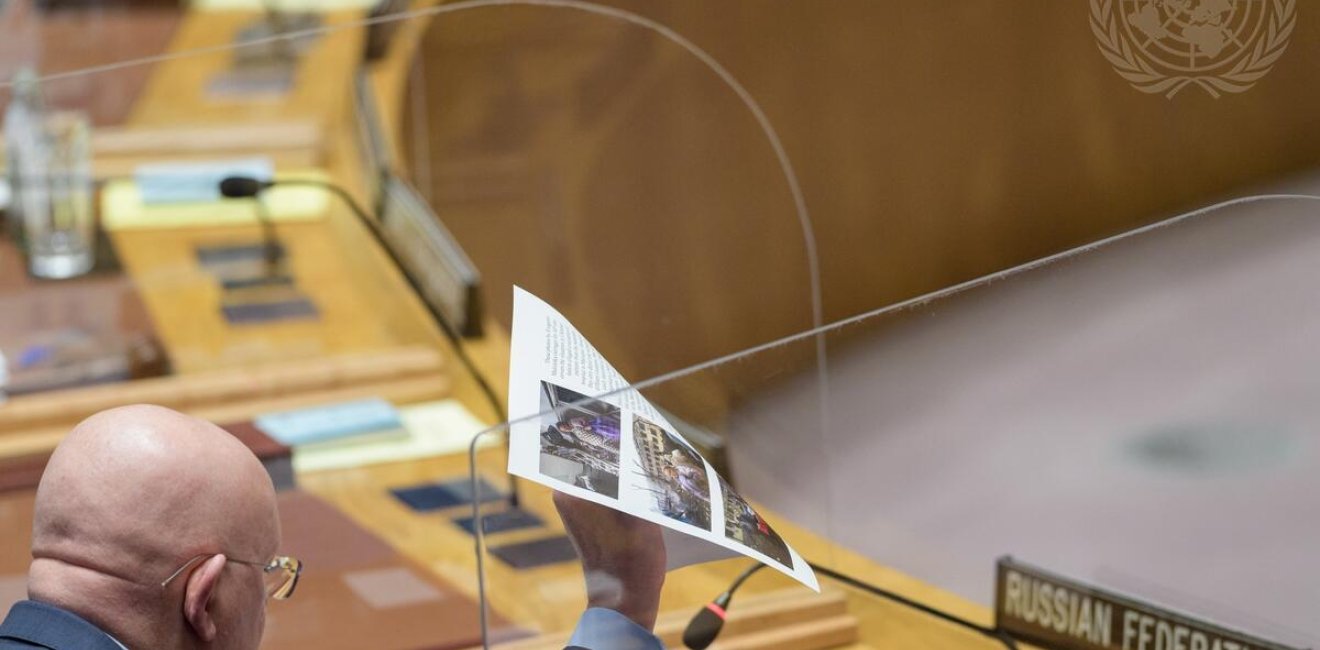The Kremlin’s propaganda machine has been operating at full tilt in a bid to justify Russia’s military aggression against Ukraine. Its preferred technologies for this “(dis-) information war” might be quite modern – e.g., Twitterbots and “troll factories” – but the themes at the center of this campaign are in fact quite old. They have their origins in Soviet disinformation during the Cold War.
This is especially the case for one accusation that stands at the forefront of Moscow’s current disinformation regarding Ukraine. The Putin regime has claimed that the US, Ukraine, or both countries have been developing biological weapons in secret laboratories on Ukrainian soil to use against Russians or Russian-speaking Ukrainians. Thus, Russia had to invade to shut them down. The zenith of this propaganda campaign to date came on March 11, 2022, when Moscow convened an emergency session of the United Nations (UN) Security Council to repeat these allegations. Russia apparently hoped to exploit the session not only to discredit Ukraine and the US, but also to rehabilitate its own reputation after an overwhelming majority in the UN General Assembly had condemned its aggression against Ukraine. The session also served as yet another platform for Moscow to spread its disinformation.
Moscow has used such “false flags” in the past to justify invasions. For example, the KGB planted a stash of US weapons near Karlovy Vary in Czechoslovakia in 1968. After their discovery by Czechoslovak authorities, the Soviet press and Moscow’s foreign propaganda claimed that Sudeten German “revanchists” and supporters of the pre-communist order in Czechoslovakia had hidden the weapons there. Moscow thus implied that a putsch against the communist government in Prague was imminent. Just as this collection of weapons served as a pretext for Moscow’s invasion of Czechoslovakia in August 1968, the presence of alleged bioweapon labs run by the US and Ukrainian “fascists” are serving as a pretext for Russia’s invasion of Ukraine today.
However, before this latest military aggression, Moscow did not need to plant any weapons, let alone bioweapons, in Ukraine. Instead, it built upon its ongoing propaganda campaign since many years, claiming that the US was constructing bioweapon laboratories in the countries bordering Russia. In this campaign, Moscow sought mainly to slander the Cooperative Threat Reduction Program of the US Department of Defense, which has contributed since 1991 to reducing the threat posed by weapons of mass destruction and the facilities previously dedicated to developing them in the post-Soviet successor states. The program focused initially on securing and arranging for the destruction of atomic, biological, and chemical weapons. In subsequent years, it assisted the governments of the post-Soviet states in, among other things, developing secure facilities for civilian, scientific research on various microorganisms, including pathogens, with the goal of preventing and combatting future epidemics and pandemics.
Shortly after the Russo-Georgian War in 2008, Moscow accused Tbilisi of permitting the US government to build bioweapon research facilities on its territory. These accusations centered on the Richard Lugar Center for Public Health Research, which in fact was a facility of the Georgian government that first opened in 2011 and became fully operational only in 2013. Despite the civilian goals of the facility, Russian propaganda still proclaims today that it is conducting biological weapons research for the Pentagon.
After Putin’s first war of aggression against Ukraine in 2014, Russia’s occupation and annexation of Crimea, and the proclamation of separatist “republics” in Donetsk and Luhansk with Moscow’s support in the same year, Russia intensified its existing “bioweapons” propaganda with regard to Ukraine. In this case, the immediate targets of the disinformation were laboratories of the Ukrainian Ministry of Health, engaged in domestic and international scientific research with some assistance from the aforementioned US program. As had been the case with Georgia, Moscow has claimed that the alleged “bioweapon” research in neighboring Ukraine represents a threat to Russia, if not also to the Russian speakers in Donetsk and Luhansk. The research laboratories in Georgia and Ukraine, Moscow suggested, might accidentally or purposely set free various pathogens that could spread across the border into Russia.
These accusations closely followed the pattern of a series of KGB “active measures” during the Cold War – namely, covert propaganda and influence measures that were designed so that their “origins, persons involved and their goals remained concealed.” One such active measure was an article in the Indian newspaper Patriot, reputedly financed by the KGB, from July 18, 1983. The article’s title declared, “AIDS May Invade India: Mystery Disease Caused by U.S. Experiments.” The anonymous author, who was allegedly a well-known US scientist and anthropologist, claimed that the virus causing acquired immunodeficiency syndrome (AIDS) had originated in “experiments by the Pentagon to develop new and dangerous biological weapons.” India’s neighbor Pakistan, it said, “may become the next proving ground for these experiments.” Thus, there was a danger that AIDS could quickly spill over Pakistan’s border to India and infect its population.
The Patriot article referred back to an earlier KGB active measure, part of its Operation “Cockroaches.” An article in the Soviet newspaper Literaturnaya gaseta, another known front for KGB disinformation, had claimed that a US scientist conducting research on mosquitoes in Lahore, Pakistan, was in fact sending them off with deadly diseases to test how effectively they might serve as carriers for germ warfare. As a result, the article claimed, the number of deaths from various pathogens had significantly increased in the region around the laboratory, which bordered on India.
According to Moscow’s current disinformation, the deadly viruses in US bioweapon laboratories in Ukraine and Georgia might spread across their borders to Russia, just as similar pathogens from other U.S. laboratories might have spread from Pakistan to India in 1983. Thus, the US-bioweapons-in-Ukraine thesis appears, in fact, to be recycled disinformation: different countries and different viruses, but practically the same disinformation thesis. The Patriot article and its reference to the disinformation from the KGB’s Operation “Cockroaches” also demonstrates how Moscow’s disinformation theses build upon previous campaigns. That is also the case with the current “bioweapon-lab” disinformation, which Moscow first directed mainly against Georgia and now increasingly against Ukraine.
At the Emergency Session of the UN Security Council on March 11, 2022, Russia’s Ambassador to the UN Vassily Nebenzia brought up a further old disinformation thesis from the Cold War. He spoke about the development of so-called “ethnic weapons” by the Pentagon, or bioweapons that, thanks to modern gene technology, will infect and kill only certain ethnic groups. According to the Russian ambassador, the Pentagon had developed such ethnic weapons to be used against the “Slavic ethnicity” through its previous collection of blood samples from COVID-19 patients in Ukraine. Such ethnic weapons, he implied, could be found in the Ukrainian laboratories.
Moscow had carried out a similar disinformation campaign in the 1980s. Then, according to the KGB’s covert thesis, the US alone or in cooperation with Israel or South Africa had developed or even used such “ethnic weapons” to kill Africans and Arabs. This disinformation campaign ran parallel to the KGB’s AIDS disinformation campaign, or Operation “Denver,” as it was codenamed by the Stasi. In the latter case, the KGB, assisted especially by the East German Stasi, spread the thesis around the globe that the US Army Medical Research Institute for Infectious Diseases at Fort Detrick, Maryland, had developed the human immunodeficiency virus (HIV) that causes AIDS as a real or potential bioweapon. In a number of publications influenced directly or indirectly by these disinformation campaigns, the alleged “ethnic weapon” developed to kill Africans, African-Americans, or Arabs was HIV itself.
The reference to COVID-19 by the Russian ambassador in his speech on March 11, 2022, was also no coincidence. Moscow has been exploiting the COVID-19 pandemic to recycle its old disinformation memes regarding HIV/AIDS. Since the beginning of the epidemic, Russia has spread the thesis in the internet that COVID-19 is in fact a US bioweapon developed at Fort Detrick, Maryland. Russian state media platforms like RT (formerly “Russia Today”) and “Sputnik News” used earlier epidemics – H1N1 or “bird flu” (2013), Ebola (2013-16) and zika (2013-15) – to spread variations on the same disinformation theme. According to Moscow’s disinformation, whatever the epidemic or pandemic disease might be, it must originate in the bioweapon laboratories of the Pentagon, whether at home or abroad.
In the case of the COVID-19-from-Fort-Detrick thesis, China has actually done more to assure its spread in the internet, the mass media, and the press. This should not be surprising, as it marks Beijing’s response to the accusation from Washington, especially by former President Donald Trump and his associates, that COVID-19 originally spread from a Chinese biological research laboratory in Wuhan to the rest of the world. This ongoing propaganda campaign by China in support of the COVID-19-from-Fort-Detrick thesis helps explain why Beijing has echoed Moscow’s bioweapon disinformation regarding Ukraine and has even been helping to spread it throughout the world.
Naturally, Moscow has a much easier time today spreading its disinformation than it did in the 1980s. The ultimate goal of the KGB’s active measures – and one assumes with regard to its disinformation today – was that the theses Moscow sought to promote would begin to spread on their own, without any further effort on its part. In the case of Operation “Denver,” a cycle of disinformation and misinformation arose, in which conspiracy theorists in the US began to cite disinformation associated with the KGB, and the KGB, in turn, began to cite publications of the US-based conspiracy theorists.
In the 1980s, it could take weeks or months before a new publication or broadcast echoing the KGB’s disinformation might appear. In the case of the alleged bioweapon laboratories in Ukraine or Moscow’s COVID-19 disinformation, Moscow’s theses began to spread almost instantly and with great speed through certain internet milieus. They have since been picked up by certain publications and broadcasters in the West and further spread by both left-wing and right-wing activists and politicians.
The officers of the KGB, the Stasi, and the Soviet-bloc security services could have only dreamed of such possibilities during the 1980s.
A German-language version of this blogpost was originally published by "H und G" on March 18, 2022.






